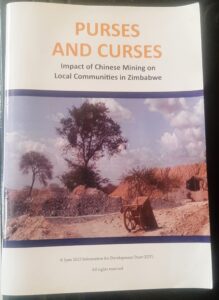Canadian gold miner gives hope amid massive environmental violations
Turk Mine turns waste dams into solar farm as other miners evade accountability over environment
Pamenus Tuso
Bubi—Turk Mine, a gold entity run by A Canadian company, has taken a lead in rehabilitating the environment, breaking ranks with some foreign investors—main from China—and local ones that have caused serious environmental damage without reclamation.
The mother company, New Dawn Mining Corporation, is listed on the Toronto Stock Exchange (TSX).
Turk Mine is located in Bubi—some 56 kilometres north-east of Zimbabwe’s second capital and off the Bulawayo-Nkayi highway in Matabeleland North province.
Mining started in the area in the 1920s before Turk Mine took over some decades ago and resumed current operations in 2009 after a spell under care and maintenance at the peak of the country’s economic crisis in the 2000s.
The gold miner has turned waste dumps or tailings dams that had existed for years into a solar farm.
The tailings dams were pouring into a nearby river and pausing serious health hazards to the nearby mine workers and their families, the nearby communities as well as flora and fauna.
The rehabilitation project commenced in 2013, with 3.6 hectares of the recovered land being turned into a 4.4 megawatt solar farm.
The electricity generated from the off-grid solar project is used to power the entire mine plant during the day.
“In 2013, Turk Mine embarked on land rehabilitation targeting all old decommissioned and neglected tailing dams.
“The tailings dams were inherited by the mine from the old miners… and were spread over 70 hectares,” explained Taurai Danda , the mine ‘s safety, health, environment and quality (SHEQ) officer during a recent media tour of the mine.
The reclamation process involved clearing 1.5 million tonnes of waste from the mining waste reservoirs.
Waste from the dumps was fed into a newly installed plant, the Deswick, which has the capacity to both re-mill the residues and introduce hazardous substances into modern tailing dams.
“While this machine (Deswick plant) has greatly assisted us in the management of our mining waste, we have also realised that there was commercial value in reclaiming the tailings that we inherited from the previous miners as we purchased the Deswick mill which has enabled us to recover gold from the mining waste that was piled up.
“Mining technology has now increased the efficiency of extraction, unlike in the past where miners used less efficient mining equipment,” said Owen Nyoni, the mine manager.
The reclamation of the dump reservoirs has come with several environmental advantages, according to Danda.
“Deforestation on virgin land was avoided while 3.6 hectares of land was preserved. (The use) of 5,453,000 kilogrammes per year of coal (to power the gold mining processes) was avoided while 116,8 million of water was saved,” said Danda.
Environmental Management Agency (EMA) Matabeleland North provincial manager, Chipo Mpofu Zuze, commended the mine for coming up with the initiative.
“I would like to comment the mining company for coming up with this project…that benefits both the environment and the local community,” said Zuze.
In terms of section 73 (2) of the EMA Act, it is criminal for a mining company to discharge hazardous substances into the environment.
Violators must pay the cost of the removal of the hazardous substances, reparation, restoration, restitution or compensation where third parties are involved.
In addition, a mining company that contravenes water pollution control standards in terms of section 57 (1) of the Environmental Management Act can be fined a maximum US$5,000 or imprisonment of not more than five years, or both.
The Turk Mine rehabilitation project comes amid long-drawn outcries over massive environmental degradation by some foreign companies in the areas they are carrying out mining, mostly those from China, Lebanon and Russia.
A study carried out by Information for Development Trust (IDT) last year revealed that several Chinese mining companies operating in various provinces were wantonly destroying the environment with EMA and other authorities failing to rein them in.

The study, which sought to explore and analyse the impact and implications of Chinese mining investments on local communities, revealed that the environmental catastrophe had negatively affected humans and livestock, leading to deaths in some cases.
Numerous investigations also sponsored by IDT have revealed extreme environmental excesses in various parts of the country.
Common environmental impacts affecting local communities include massive deforestation, un-reclaimed pits, introduction of hazardous substances into the soil and water, razing down of mountains and hills with traditional value, air pollution and the diversion of rivers.
And local mining companies have also come under the spotlight for poor environmental damage, among them Better Brands, a gold mining company operating in the Penhalonga goldfields in Manicaland province.


